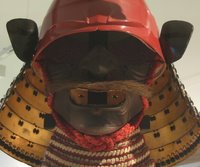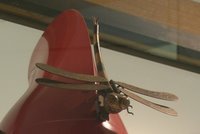Japanese Armour
Recently, I attended a 'Japanese Arms and Armour' exhibition at Benalla, in country Victoria; it was a long drive and the exhibition was limited, but the visit was fascinating and well worth the effort. This is the first of several posts showing the exhibition's contents. All photos were taken using a Nikon Coolpix 5400 mounted on a tripod. The gallery staff were obliging enough to let me take the photos, provided I didn't use a flash. Luckily, the lighting was great. I was also fortunate enough to attend on a week day, obviating the need to contend with crowds. The photo above shows an iron eboshi kabuto (helmet) coated in red lacquer and rising from a four-plate iron hachi (bowl). It dates from the mid-Edo period (1750-1800), but is fashioned in the shape of the Heian period (782-1167) eboshi, worn by courtiers and high-ranking samurai, reminding us that fashion truly is cyclical.
The photo above shows an iron eboshi kabuto (helmet) coated in red lacquer and rising from a four-plate iron hachi (bowl). It dates from the mid-Edo period (1750-1800), but is fashioned in the shape of the Heian period (782-1167) eboshi, worn by courtiers and high-ranking samurai, reminding us that fashion truly is cyclical. The menpo (face mask) dates from the same period as the kabuto. It is shaped with an open mouth and a horsehair moustache. While it looks like a russet iron surface, the maedate is actually iron covered in lacquer, just like the helmet. The maedate is in the form of a katsumushi (dragonfly). The body of the dragonfly is constructed of brass, while the wings are hinged and detailed with black lacquer. All in all, the piece was well preserved and striking to behold: the katsumushi is particularly engrossing, with exquisite detail.
The menpo (face mask) dates from the same period as the kabuto. It is shaped with an open mouth and a horsehair moustache. While it looks like a russet iron surface, the maedate is actually iron covered in lacquer, just like the helmet. The maedate is in the form of a katsumushi (dragonfly). The body of the dragonfly is constructed of brass, while the wings are hinged and detailed with black lacquer. All in all, the piece was well preserved and striking to behold: the katsumushi is particularly engrossing, with exquisite detail. The katsumushi or tonbo (the name more familiar to modern readers) is a common motif on Japanese arms, armour and clothing. The term means 'invincible insect', and for the bushi it represented courage and perseverance in battle. It is also referred to as the kachimushi, or 'victory insect'. The power of the motif is uniquely reflected in Tonbogiri, the Dragonfly Cutter. Tonbogiri was one of three legendary spears made by the swordsmith Masazane (active during the Muromachi period), and was so named because a dragonfly (perhaps apocryphally) landed on its blade and was instantly cut in two.
The katsumushi or tonbo (the name more familiar to modern readers) is a common motif on Japanese arms, armour and clothing. The term means 'invincible insect', and for the bushi it represented courage and perseverance in battle. It is also referred to as the kachimushi, or 'victory insect'. The power of the motif is uniquely reflected in Tonbogiri, the Dragonfly Cutter. Tonbogiri was one of three legendary spears made by the swordsmith Masazane (active during the Muromachi period), and was so named because a dragonfly (perhaps apocryphally) landed on its blade and was instantly cut in two.
Unfortunately, this was the only piece of armour at the exhibition, but a number of swords and associated fittings were also on display. Plenty of photos and information will follow, so I hope you like this sort of thing. Larger versions of the photos are available upon request, provided they are not used for commercial purposes; they make good wallpapers.
I would like to acknowledge the generosity of the members of the Australian Society for the Preservation of Japanese Art Swords, who made their collection available for public viewing. I'd also like to thank the Benalla Gallery, which did a wonderful job of putting these beautiful objects on display.

No comments:
Post a Comment